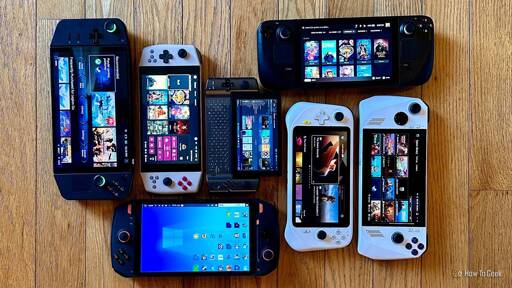Article says:
I’ve been closely following handheld PCs ever since Valve announced the Steam Deck. In the years since, they’ve only gotten more expensive without offering meaningful performance improvements. Worse still, it looks like every new PC handheld is bigger than the previous one. What gives?
The Price Is Not Right
As a handheld PC buff and the resident handheld PC reviewer over at TechPowerUp, I’ve seen and used my fair share of PC gaming handhelds. Aside from the Steam Deck LCD, the common feature they all share is the high price of admission.
Even the Steam Deck OLED and the ASUS ROG Ally, the two “affordable” options on the market, will set you back $550 and $650, respectively, which is a pretty penny.
Virtually every Windows PC handheld, including popular options from big-name brands such as ASUS, Lenovo, and MSI, can be considered a luxury commodity made for hardcore PC gamers ready to pay the premium for a handheld capable of running all their favorite PC games.
Instead of more competition driving prices down, the average price you need to pay for a PC handheld has been steadily on the rise ever since the Steam Deck made them part of the mainstream gaming milieu. I had hoped big-name vendors would one-up Chinese boutique brands and their overtly expensive offerings, but the reality tells a different story.
For example, devices powered by AMD’s Z1 Extreme chip entered the market at about $700, the MSRP of both the original ROG Ally and Lenovo Legion Go. The ROG Ally X, a souped-up version of the original, debuted at $800, but now costs $900 thanks to the tariffs.
The Legion Go S, which Lenovo touts as the company’s “more affordable [PC handheld] option,” retails for $600 for the SteamOS version with the Z2 Go that’s a bit more powerful than the chip powering the Deck. The SteamOS version coupled with the Z1 Extreme, comparable in power to the ROG Ally X, sells for $830.
Handhelds powered by AMD’s Z2 Extreme chip are even costlier. The most affordable Z2 Extreme version of the Legion Go 2 is priced at an eye-watering $1,350, while the Z2 version (comparable in performance to the Z1 Extreme) coupled with a meager 16GB of RAM, will sell for $1,050! Even without the tariffs, these prices are not right.
The only Lunar Lake handheld you can buy at the moment, the excellent but also pricey MSI Claw 8, will set you back $1,000, while its cousin, the Z2 Extreme-powered Claw A8, is selling for €999 over in the EU, which means it too will break the four digit barrier once it finally lands in the US.
You can bet that the upcoming ROG Xbox Ally X from ASUS and Microsoft will also sport a similar price, showing that, as time goes by, PC handhelds are only shooting up in price instead of the other way around.
Instead of getting more affordable over time, the recent crop of “affordable” handhelds sport the same prices as high-end ones did just a few years ago, while the high-end options cost as much as budget gaming laptops, without offering worthwhile performance improvements.
Pricier, Without Worthwhile Performance Improvements
New PC handheld devices being prohibitively expensive wouldn’t be such an issue if they brought worthwhile performance improvements.
But the reality isn’t as rosy. Credit where credit’s due, the Z2 Extreme does deliver impressive performance gains at low power (anything from about 40% at 15W to impressive 2x performance jumps at 10W and below), but at 20W and above, the gains are quite slim. We’re talking around 20% improvement, with some games seeing even slimmer gains.
This is not enough to justify the exorbitant prices of Z2 Extreme handhelds, and it looks like AMD is the main culprit here, not vendors. I mean, AMD flat-out said that “We charge more for our CPUs than our competitor does,” with that competitor being Intel.
Case in point are two MSI handhelds that offer very similar gaming performance. The MSI Claw 8 powered by Intel’s Lunar Lake platform, which I reviewed, is built like a tank, made of high-quality materials, and has an impressive cooling setup consisting of two fans and two massive heat pipes.
On the flip side, the Z2 Extreme-powered MSI Claw A8 costs the same as the Claw 8, but features a shell made of lower tier plastic, its cooling setup packs louder fans and only one heat pipe, and you’re only getting 24GB of RAM instead of 32GB, as found on the Lunar Lake model.
Personally, I think AMD made a mistake keeping the Z2 Extreme on the now dated RDNA 3.5 architecture. The chip didn’t bring worthwhile performance improvements; it’s still stuck with temporal upscaling (FSR 4, reserved for RDNA 4 GPUs, is machine learning-based just like DLSS), while costing much more than the Z1 Extreme.
Since we won’t see RDNA 4 GPUs in mobile APUs, and with rumors saying AMD won’t make Z3 chips anytime soon (if ever), it looks like mainstream PC handhelds won’t get noteworthy performance gains for at least a few more years, which is grim news for PC handhelds fans.
Intel could come to the rescue with its upcoming Panther Lake series of mobile chips, but as of this writing it looks like we won’t get a low-power chip coupled with a beefy iGPU like we did with Lunar Lake.
Truth be told, Chinese brands such as GPD and Ayaneo are working on handhelds powered by AMD’s high-end Ryzen AI Max 385 and Ryzen AI Max+ 395 APU (also known as Strix Halo) that should offer performance similar to the laptop version of the RTX 4060. But the catch is that these two APUs are designed to run at very high power envelopes. Their optimal TDP is set at 55W, which is bonkers for a handheld PC!
GPD and Ayaneo have also had to compromise the design of their upcoming handhelds to make Strix Halo APUs work in a handheld form factor. For instance, the GPD Win 5 doesn’t even have a built-in battery; you have to use an external battery (included with the device) that connects to the handheld via cable. Lastly, they will be super expensive; the most affordable version of the GPD Win 5, featuring the Ryzen AI Max 385, costs around $1,220, and that’s the preorder price for the Chinese market. You can bet the regular prices for markets outside China will be notably higher.
It seems like PC handhelds are hitting a wall regarding gaming performance, a wall they won’t surmount for at least a couple more years. Sure, we will get devices powered by AMD’s Strix Halo, but these will be exotic, luxury devices aimed towards well-off enthusiasts and not your average PC gamer who’d like a taste of that sweet handheld gaming PC life.
When a Handheld Is Too Big to Be Called Handheld
There’s another handheld PC trend I’m not very fond of: the average handheld PC is getting bigger and bigger.
My How-To Geek colleague Bertel King has already written about this and I tend to agree with him: PC handhelds are getting too large.
The first mainstream PC handheld, the Steam Deck, made a 7-inch screen the standard. Then the 8.8-inch Lenovo Legion Go arrived and broke every record size-wise. Nowadays, it looks like 8-inch screens are becoming the sweet spot.
Now, honestly, I’m fine with an 8-inch handheld as long as it has as good weight distribution and ergonomics as the MSI Claw 8. But even that size is pushing it. As someone with medium-sized hands, I had a hard time reaching the bumpers on the Claw 8 while testing it, and had to remap the bumpers to the two bottom buttons.
The Legion Go 2 is even worse in this regard with its humongous 8.8-inch display and weight of more than 2lbs, making it heavier than many thin and light laptops. Other behemoths include the 8.4-inch Ayaneo Kun, the missing-in-action 10.95-inch Acer Nitro Blaze 11, and the upcoming 11-inch Abxylute 3D One.
Worse still, even Nintendo and Sony have embraced this trend of supersizing. The Switch 2 is humongous compared to its predecessor, thanks to its 7.9-inch screen and weight of 1.18lbs, which is getting dangerously close to the PC handheld territory. The PlayStation Portal isn’t as heavy, but its 8-inch screen does make it quite large compared to PlayStation handhelds of yore.
Can the PC Handheld Market Be Turned Around?
PC handhelds are getting more and more expensive and larger without offering worthwhile performance improvements. Can the PC handheld market recover? Performance-wise, I don’t see the trend of drip-fed performance improvements dying out anytime soon.
Sure, creating a bespoke APU design that pairs a relatively humble CPU with a beefy GPU and high-bandwidth memory would be possible in principle, but PC gaming handhelds aren’t popular enough for AMD, Intel, or NVIDIA to work with vendors in creating such a chip.
The first PC handheld that could come with a semi-custom solution is the Steam Deck 2, but that one’s years away.
I reckon that the rumored PlayStation handheld will boast quite a beefy bespoke APU made by AMD that will likely put most PC handhelds to shame. If we’re lucky, and the handheld PlayStation ends up selling like hotcakes, perhaps AMD will ultimately offer something similar to PC handheld vendors.
When it comes to the ever-increasing prices, I can see them stabilizing, but I don’t think any other PC handheld will come close to the Steam Deck LCD anytime soon.
The reason is simple: Valve earns money from selling games with the Steam Deck being a sort of vessel for selling Steam games, allowing the company to offer it for only $399.
Luckily, if you aren’t interested in playing the latest and greatest PC games, you can pick between buckets of various retro handhelds, some of which (like the upcoming AYN Odin 3) pack powerful mobile chips capable of running many PC games via Android apps such as Winlator.
Or you can simply get a Switch 2. It’s not a handheld PC, but it’s still an awesome portable gaming machine. You can also opt for a preowned Steam Deck or ROG Ally, both of which can be found at attractive, “budget” price points over at eBay and Facebook Marketplace.
I believe we will get a proper budget PC handheld that isn’t a Steam Deck once the market matures, more players enter the fray (HP, Alienware, Razer, and so on), and we start seeing some real competition. The downside here is that this likely won’t happen anytime soon.
Lastly, while the sizing-up trend is in full swing, there are still options catering to PC gamers that prefer more compact handhelds. You’ve got devices such as the ROG Ally X, the upcoming ROG Xbox Ally X, and the MSI Claw 7, each packing more compact, 7-inch screens.
What I would like to see next is more devices featuring 6-inch or smaller screens. Unfortunately, the majority of PC handheld buyers prefer larger, less portable devices. I don’t think big-name brands will offer something as portable as the Ayaneo Air 1S or the GPD Win Mini. That’s a shame, because I’d love to see a Steam Deck Mini.
At the end of the day, I’m still excited about the upcoming PC handhelds. But I don’t like this trend of ever-rising prices coupled with disappointing performance improvements, which will hamper the steady adoption growth PC handhelds have enjoyed since the release of the Steam Deck.
Honestly, I somewhat like some of these trends, such as the bigger screens and yet… there are drawbacks and the prices are ridiculous.
I prefer some of the Chinese brands such as the Sugar handhelds because they’re at least kinda wacky and different as well as powerful.
Your thoughts?___
Or you can simply get a Switch 2. It’s not a handheld PC, but it’s still an awesome portable gaming machine.
I have pirated a preposterous number of games on my Steam Deck so I would advicd against this.
LMAO
more competition would mean lower prices, commies!
uh…that doesn’t seem like it
a handheld device was not meant to be held in your hands, commies!
seems legit
Totally legit. /s
I like the chinese android handhelds more. They are affordable, emulates old consoles and now even lite pc games. And most people on steam deck are playing Hades anyways.
I like the Steam Deck OLED, but that thing is still too expensive.
I agree on the Chinese handhelds, such as the OneXSugar 1.
Prices are so wild with every new release, especially given the gains are not great. They really need to figure out some game changing ways to cool the devices in order to get more performance out of the chips without just defaulting to just sticking even more thermally intense releases. We just get chips that are more and more expensive that don’t reflect prices. And just means it sucks so much worse if they get dropped (being handhelds) or stolen. Like it sucked if my GBA or even PSP where to get stolen, but at least the price for a new one wasn’t anywhere near as bad of a hit to take.
The current state of how games are made doesn’t help either. They don’t put in anywhere near the levels that games from decades ago did to optimize to get everything possible from the hardware. It is cool to see/hear about how devs would pull off wild stuff on consoles in the 80’s/90’s given the specs. Same can be said of PC games in the 90’s being much more playable on potato pre-builds that were “the family computers.”
But now we are lucky to even get high-end builds to run correctly on launch (let alone the average hardware). Seeing the GHz number means nothing functionally anymore (not a great metric even before). A 3GHz Pentium or Athalon feels like it might as well say 800MHz with how bad even just booting and opening Windows Settings runs. Getting a $500 card seems to mean needing to just turn off so many things (even though the card companies love to put “gaming” on them and talk about ray tracing (but at bad performance and needing to default to DLSS/FSR to be anywhere close to 60fps). The handhelds and their ability to be used as a regular PC connected to a TV/monitor really have the chance to bring more people to PC gaming while also being really useful. But much like laptops, they don’t “feel” like the hardware is actually being fully used. Obviously there are bumps here and there, but they aren’t noticeable in the ways upgrading PCs or even consoles felt in the 90’s and 00’s.
All the nice charts and graphs get brought out, but in use they seem like placebos at best. Though the hardware manufacturers don’t get all the blame for it. The software devs for even non-gaming programs just love to waste resources as if they are THE only programs you will use. Can see this daily at my job seeing how basically all the major programs now default to running on start-up. And even if they offer a option in the program to actually turn that off, they now love to only give that option if you sign in. You accidentally open Spotify? Now it launches on startup and can’t be officially disabled or removed from the list of startup programs in Task Manager until you sign-in (and even then it is not obvious right away how to do so). Creative Cloud both not signed in or fully signed in goes nuts too. So many times I am able to make customers’ PCs seem brand new by just being OCD about disabling all the game launchers, chat apps, and whatever else (especially on laptops).
The current state of how games are made doesn’t help either. They don’t put in anywhere near the levels that games from decades ago did to optimize to get everything possible from the hardware. It is cool to see/hear about how devs would pull off wild stuff on consoles in the 80’s/90’s given the specs. Same can be said of PC games in the 90’s being much more playable on potato pre-builds that were “the family computers.”
Even Nintendo seems to be lagging behind in this area now that their own hardware is more up-to-date.
I don’t own a Switch (new or old), but I know those consoles are still not working with the same raw power as Sony and Microsoft. Given how much effort and money they put into hunting down copyright stuff. Really seems that they could redirect even a portion of those resources into making full use of the hardware and provide help to devs/studios for optimizing games. Though I know it is easier to optimize their legal attacks compared to game optimization.
Noticed only after I finished typing that I went into the below rant like my original comment. Feel free to ignore since the above relates to your reply. lol
I was/am hoping that given the popularity of the Steam Deck, that it will benefit more PC games to be at least a little better (both for Linux and lower spec hardware). But would still need a lot more people to buy Decks over the other more pricey options, and for the definition of “verified for deck” to be 60fps (really hate that 30 is still pushed by studios and outlets as the standard at this point). And would of course need for the studios to fear dramatic drops in sales of their IPs on all platforms (though I imagine they would rather close studios before caring about better code).
Stuff like DLSS/FSR also don’t help in making studios/devs care to bother, or make the GPUs actually better for 1400p/4k (not looking forward to fake 8k) unless you turn the option on. Just so many excuses while charging more and more. The dramatic jumps in prices for the consoles and components further makes things worse for even wanting to play games. I can’t imagine being a parent and having my kids that want to game these days (consoles being like $300~$400 for a “it just works and can play basically all games” are now costing more than launch prices. Even though that is in-part due to tariffs, it still makes it really hard for lower income households. So it means now more than even a few years ago that these games actually run super well to justify all the money. All that will remain are mobile crapware that are ads with game elements.
I agree with the price points. I looked at a steam deck briefly and they’re very expensive for what they do, and I’m not entirely sure what they do. I was looking at an emulation machine because I refuse to buy new consoles anymore and thought I could also play some games with fan translations and stuff like that, but of course you can’t upgrade a PC handheld while video games demand more and more specs every year. So how long will the expensive steam deck even last me? It’s not worth paying these prices for just an emulation machine.
When I say emulation I mean ps2 and up. Some more expensive android machines can play ps2 games but I doubt they can play switch games - though I’m able to play some of them (the lighter ones) on my huawei phone. And with the switch 2, I expect an emulator to come out in a few years which I need to know will work on a handheld to justify the purchase.
I might be interested if you can stream games from your PC to the machine though. That way I might be able to emulate games on my PC and play them on the machine. And since you’re just streaming a video you’re also not capped by specs when newer games come out. Interested to know if that’s possible if anyone has a deck.
Lastly one thing that I think is not talked about a lot is experiencing a game on different machines makes for a different experience imo. I don’t know how to describe it, but I feel a difference playing a game on console TV, PC or handheld.
but of course you can’t upgrade a PC handheld while video games demand more and more specs every year
These devices are not meant to play AAA games. It is what the manufacturers advertise but they are lying. Unless you can look past terrible performance (20-30 fps) and battery life. Valve marks AAA games as “Steam Deck Verified” willy-nilly but most run awfully on it. Best option you have for this slice of games is have them run on a gaming PC and stream them using something like Moonlight.
I use my Steam Deck for low end games and emulation mostly. Laat game I finished on it was Silksong. Right now I am giving Hades 2 a whirl. These kinds of games run great. It is also essentially a handheld computer so I also use it to watch Jellyfin.
Yes but it will play the AA games of 5 years in the future? And that’s just the raw power, not even mentioning how tech handles things differently and 5 years from now unity might use a new rendered that is incompatible with the handheld. The LCD is affordable enough but it’s a steep entry price for something that may not last as long as a full console!
Could AA games become more resource hungry in the next five years? It is possible but unlikely. Even if it becomes a trend then at least some games will definitely exist that won’t be resource hogs. Engines breaking compatibility is also unlikely. As I said the thing is essentially a computer. The only things that make it a handheld are the form factor and peripherals. Regardless of these two points a huge backlog of games will continue to exist. At that point it won’t justify the price tag that Steam Deck has today but if you could get one cheap you could crank out insane value from it.
I’m currently playing Fallout 4 on my Steam Deck. The impressive caveat here is that I’m also running 800+ mods on it. I also used my Steam Deck to play Grounded 2’s early access when it came out. I’m not here to boast about the performance or anything, neither broke 40 FPS, but both maintained a stable framerate. I feel like you’re underestimating the use cases for the Deck.
Well yes of course I am, I don’t own one haha
I think at this point enough games are already out that you could make gaming your sole focus and you wouldn’t run out of fun content you can play on steam deck from now until the day you die. I don’t think focusing on games as they come out is always a good idea, plus there are still games deliberately targeting low-end hardware like Silksong. I see no reason for this trend to end, be it in 5 years or 50.
Of course, the hardware on the steam deck wouldn’t literally last that long, but you could restrict yourself to its power and still be covered for a lifetime, or several. Depends on what you like playing and how you view consumption.
the steam deck is just a glorified portable computer running a linux distro. if the distro can be unlocked, it can do anything you want to.
oh good point, i suppose
Actually, the Lenovo Legion Pad Y700 2nd gen that I have can play most games nowadays and that’s an Android tablet. And the Lenovo Legion Pad Y700 4 can play even more; it’s about as up-to-date as most PC handhelds. I would suggest looking into it if you want to game on an Android device. The Chinese ROMs (one of which I have) are half the price on AliExpress; I saw one for $300 for what would be an otherwise $450 device in the USA and most PC handhelds are about $600 to $700 so you’re getting a lot of bang for your buck…
…But I’m sort-of iffy on that “bang for your buck” part I mentioned because you can’t play your Steam games on an Android device; it’s only recently that many companies port their games to Android devices or even design mobile games that are just as good as their console or PC counterparts and that phenomenon is still new. Also, you can use the new GameNative app to play Steam games that you own on your Steam library but it’s still a bit wonky (still better than the Pluvia open-source app, which is barely supported nowadays). Streaming apps like Nvidia GeForce Now have gotten better, but if you want to play a good high-end game with 3D graphics at moderate or high settings than a Lenovo Legion Pad Y700 4 is your best bet (with, of course, the open-source GameNative app or emulation). There’s also the fact that Valve may be working on having an app that can play Steam games on Android devices (hence why more and more Android devices lately have been adopting hardware architecture that can play the games you have on Steam), but that last part is speculation. GameNative app is the way to go for now.
One last thing:
You can also use Winlator if you have games that you download nowadays from GOG (usually through transferring GOG files from your PC to your Android tablet, which can be done easily with the Smart Connect app, at least in my own individual case). But Winlator is wonky as well. I think there’s a better alternative to Winlator, but I could be wrong. Oh yeah, and then there’s RetroArch but that’s for emulation of old games up to the, say, the Nintendo Switch, I think.
Lastly one thing that I think is not talked about a lot is experiencing a game on different machines makes for a different experience imo. I don’t know how to describe it, but I feel a difference playing a game on console TV, PC or handheld.
That’s the case for me. I prefer my PS5 on a console experience, but occasionally stream my PS5 games to my tablet (with a spectroscope controller wrapped around it) using the PS Play app. It’s a good experience so far. The only problem (which doesn’t really bother me) is that occasionally on a windy or dreary day with clouds (or both) you get lag, but otherwise, it works like a charm, though make sure to also make it that your screen is not too bright since it looks different on your screen, at least slightly. Oh yeah, and for Steam games, you can stream using the Steam Link app.
That said, GeForce Now app can also play your Steam games (without necessarily activating Steam games on your computer or laptop) so you can stream using the cloud so there’s also that. And the spectroscopic controllers that go around your tablet are pretty good now. They tend to look like this. This one is similar to what I have.
Honestly, there’s a lot of options for gaming nowadays, which I like, but I’ve noticed one thing in particular that dogs me and that is that gaming is also more expensive than it was 10 or 20 years ago. No more renting, and the games themselves are about $70 or $80, which will eat at your finances. Oh yeah, and the consoles are more expensive, such as the PS5 Pro, and even the Chinese brands, while tending to being better or more interesting than the American or European brands (again, looking at the OneXSugar brand), also are more expensive. The new Rog Ally that was done in collaboration with Microsoft is literally a thousand dollars. And I saw one console from China that was $1,699.99. That’s insane. And wages have stagnated while there is a cost-of-living crisis in the West and in many other countries.
Well, that’s the downside anyway.
Overall, I would say that gaming is technically better than it has been (in terms of quality of games and the options you have) but the horrible business practices by many companies and the bad economy along with the price points of most games, devices, peripherals, etc. just makes it barely enjoyable or unenjoyable for most people.
I’m not a pessimist and I don’t get all “doomer” about gaming in general since I like the games that come out nowadays compared to, say, the 2000s decade, but honestly, I understand why some people are “gaming doomers.”
Okay, well, star this comment if you want since I put info here that might be of use to you, but otherwise, hope this helps!
I just want a new DS. Switch is not a handheld, and steam deck is ridiculous.
I miss the 3DS…
“I review PC handhelds for a living” reminds me of that HGTV meme.
“I spit shine vacuum cleaners for mentally unstable circus clowns and my husband teaches rhesus monkeys to waltz. Our budget is 7 million snails and the President of Croatia. Help us build our dream home!”
Eh, I don’t begrudge certain people their comfy jobs; if they have it, good for them, I guess.
¯_(ツ)_/¯
Oh I wasn’t judging. I’d love to have a cushy job like being a reviewer/critic myself.
It just reminded me of that meme.
Oh lol gotcha

















